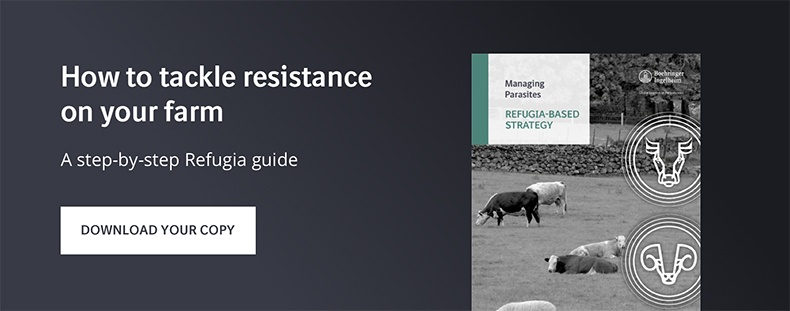Greater parasite burden when dosing cattle after wet summer and mild December
Farmers needs to be aware prior to dosing cattle that High levels of worm disease in young cattle and productivity losses in adult dairy cows are a serious risk during the coming grazing season as infective gutworm at grass pose an immediate challenge at turnout.
The level of infective parasite larvae that persists on pasture following the winter period, and the scale of the challenge cattle face at turnout may be greater following a summer 30% wetter than average1 and a mild December across much of the UK. These overwintered larvae can quickly infect cattle at turnout, and by mid-summer susceptible young stock will have established significant infections and be shedding high numbers of eggs. This rapid increase in pasture contamination can cause heavy parasite burdens in untreated animals, with resulting losses in productivity and performance, and the risk of outbreaks of disease.
Calves and youngstock are most at risk of parasite disease
Boehringer Ingelheim, advises that calves in their first grazing season are most at risk of parasite disease, and heavy parasite burdens will cause ill-thrift and potentially severe calf scour. Gutworm also has a potential impact on future performance, particularly fertility. Sub-clinical growth checks mean heifers take longer to reach target weight for first service, and can take longer to get in calf, with multiple inseminations often required2.
Youngstock in their second season at grass may also be at risk from disease, depending on the level of immunity they acquired in the previous season, and even adult cows should be considered in a farm’s parasite control plan.
Adult cows can also be infected by gutworm, though they carry lower parasite burdens, shed fewer eggs and don’t show outward signs of parasite disease. The effect on dairy productivity is well documented; milk production decreases by at least one litre per day in affected animals and the additional potential for reduced dairy fertility with increased calving to conception ratios2,4 adds to the overall dairy performance impact.
Worming plan when dosing cattle at turnout
The negative effects of gutworm can be avoided through a combination of pasture management and strategic or targeted parasite treatments. Farmers should discuss the options with their vet or SQP (Suitably Qualified Person) at their animal health supplier to identify the best approach based on the farm’s individual requirements.
In youngstock, a strategic parastie plan, including timed treatments of a suitable wormer such as those containing ivermectin (e.g. IVOMEC® Classic Injection, or IVOMEC Pour On) at three, eight and 13 weeks after turnout can help to prevent parasitic disease. Taking this approach early in the grazing season will prevent the amplification of worm populations in affected animals ensuring pasture contamination remains low throughout the season.
This approach will only be fully successful if animals are set stocked or moved onto lower-risk pasture, such as silage aftermath, later in the season, and the risk should be reassessed if new cattle are introduced to the group.
Dosing cattle to minimise wormer resistance
Alternatively, a targeted approach, where animals are treated following an assessment of the individual or group disease risk, could be adopted. Here, information such as the growth rates of cattle is monitored and used in conjunction with diagnostics, such as faecal egg counts, to determine whether wormer treatments are required.
A targeted approach has the potential advantages of reducing the risk of selecting for wormer resistance by only treating those animals that need dosing, and potentially reducing cost. But, it does require forward planning, attention to record keeping, and additional stock management time.
MOO test
Alternatively, a targeted approach, where animals are treated following an assessment of the individual or group disease risk, could be adopted. Here, information such as the growth rates of cattle is monitored and used in conjunction with diagnostics, such as faecal egg counts, to determine whether wormer treatments are required.
For dairy cows, a bulk milk Ostertagia ostertagi test (MOO test) is a useful diagnostic tool that assesses the level of gutworm antibody within a sample and provides an indication of the herd-level gutworm exposure (high, medium, low), and the likely impact of this challenge on the herd’s milk production.
Zero-milk withhold pour on
Using a zero-milk with hold eprinomectin wormer, such as EPRINEX® Pour-On in the UK or EPRINEX® Multi Pour-On in Ireland in lactating cattle provides effective gutworm control at any stage of production, without the loss of milk sales.
Using the correct equipment when dosing cattle
Using the correct equipment, properly calibrated, will ensure that dosing is accurate and effective. Cleaning and servicing existing applicators and dosing guns now, or purchasing replacements, will save time later in the season.
The Breaze™ applicator supplied by Boehringer Ingelheim, is designed specifically for use with EPRINEX® Pour-On in the UK or EPRINEX® Multi Pour-On in Ireland , and can dispense up to the full 80ml maximum dose for a 800kg cow in one go, without the need to refill the gun.
Click here for product legal furniture.
